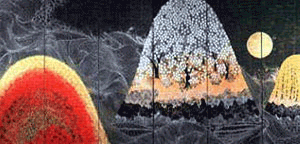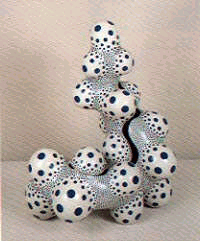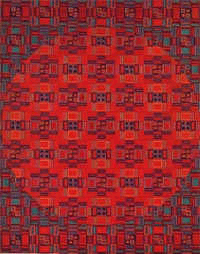|
POWER OF FORM
|
|
|
A sense of fun seems to have prevailed during the selection process
for this exhibition which includes something for everyone in its survey
of contemporary craft and art. Putting a melted burnt-out toaster in a
cabinet together with superbly crafted glassware may seem a bit strange.
However, in this exhibition they are linked by both being "blobby" things.
Blob-like forms in this area, striped things in that room, bright colors
are hung here and things with polka dots all over them go over there;
this is the sorting and display process used to curate this show.
The simple display device - linking art and craft objects by form
- opens up a Pandora's box of arguments that have raged for at least the
past two centuries about the difference between art and craft.
|
|
| In this exhibition, well known European and American painters
such as Wassily Kandinsky and Albert Gleizes are exhibited as part of a
predominantly Japanese contemporary craft exhibition. The paintings, which
are on loan from the temporarily closed National Museum of Modern Art, are
not just hung in the same rooms as the craft but are matched by color and
design. Is this a trivialization of fine art and a glorification of craft?
An answer for me was in Yasokichi Tokuda's porcelain bowls, richly colored
in overglazed enamels. They are as spiritually uplifting as any works on
canvas I have seen. Whether you can put the fruit in them or not -- my sometimes
guide to what is craft -- becomes irrelevant. |
|
| The stand out object in the first room was Itsuo Kaneko's
neck ornament. A sort of wearable sculpture of bone-like things. In a neighboring
room an erratic selection of paintings explores the theme 'pictorial form.'
In it, Nihonga paintings such as Kayo Yamaguchi's cloyingly cute Deer in
Tobihino (1965), deer of gold leaf in a blue mist, hangs with western works
such as Albert Gleizes Composition with two Female Nudes (1921). This is
a strident cubist work that dominates the room. Whereas, Toshinobu Onosato's
psychedelic painting Work 100-B (1963) holds its own against the carnivalesque
Kandinsky painting The Whole (1940). |
|
| Looking more like something that has returned through the
atmosphere from outer space, Yohei Nishimura's Toaster 1988 is a nightmare
of burnt clay, glaze and iron. More refined and craft-like in execution
than the Toaster but sharing the same degree of fun and irreverence is Harumi
Nakashima's A Hard Struggle V-1 (1995). This bubbling breast-like ceramic
form covered in polka dots has a Pop Art-ish look. Its blue and white glazing
parodying Japan's famous blue and white ceramic tradition. Cheekily hung
just behind this piece is Ei-kyu's (1958) painting, Spots among the Blue.
|
|
|
The joy of mixing the traditional with the modern is also found
in the detail of the kimono by Tokujiro Kojima. On a tie-dyed silk background,
Kojima has playfully stenciled designs of Japanese hiragana characters
'i,' 'ro,' and 'ha.' In the final room of the exhibition is a flower basket
by Shounsai Shono. Shaped like the Sydney Opera House, it is linked by
its surging form and rhythm of line to the superb silk painting by Matazo
Kayama, Waves in Spring and Autumn (1966). Repetitive lines are used to
create swirling forms of waves which surge around forested islands. Kayama
has created a masterpiece of linear rhythm and movement and it's a fitting
finale for the exhibition.
Escape the summer heat to this picturesque, red-brick museum hidden
in an island of tranquillity near the Imperial Palace.
|
|
|
POWER OF FORM through September 17
The National Museum of Modern Art, Tokyo Crafts Gallery
The National Museum of Modern Art, Tokyo 1-1 Kitanomaru Koen Chiyoda-ku
Tel: 03.3272.8600 Adults ¥400 Children ¥70 (Free - Sept. 6 & 9) Open 10:00
-16:30
|
|



